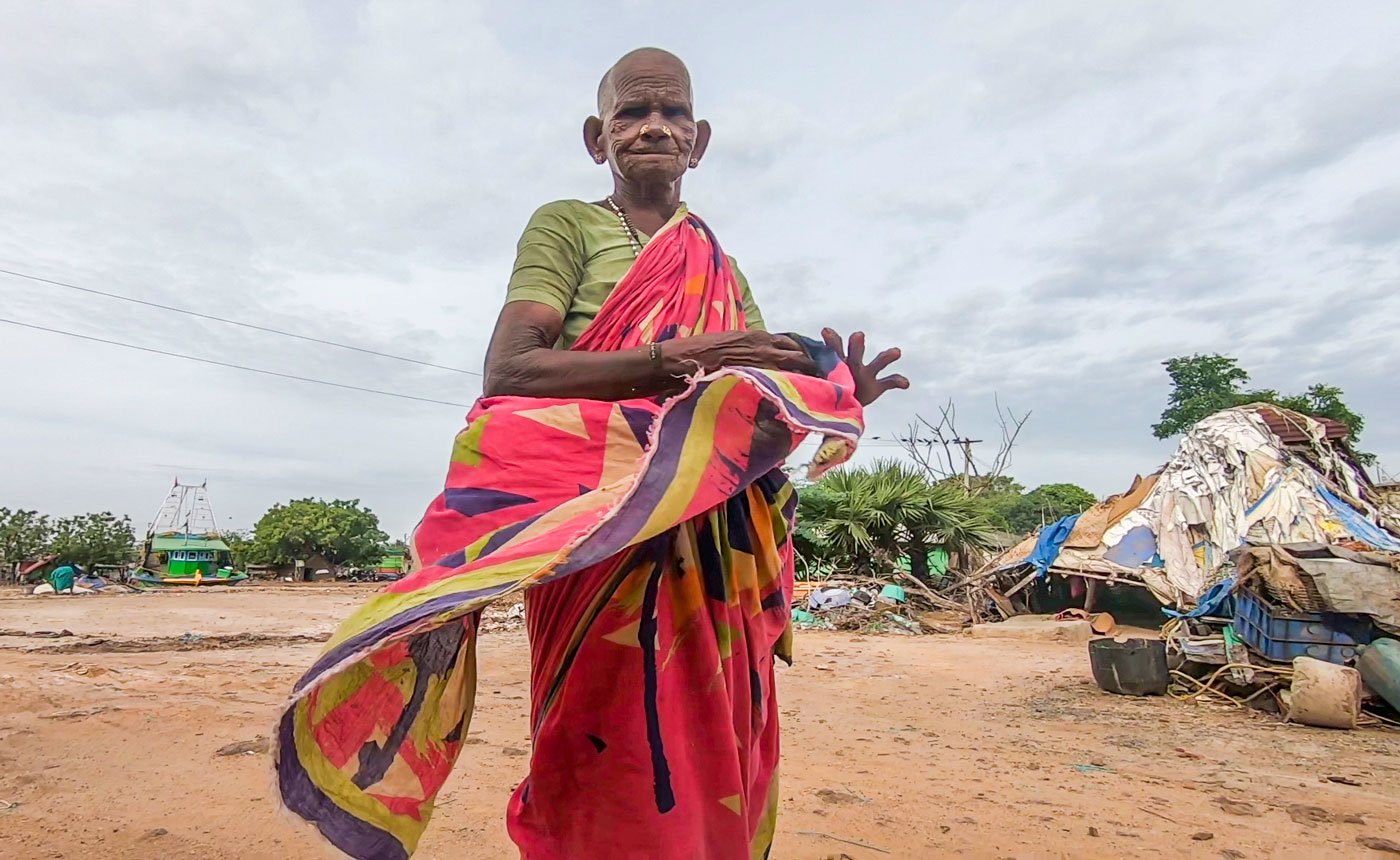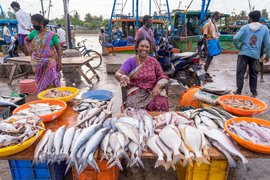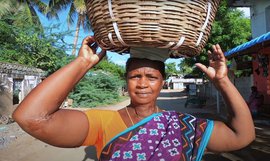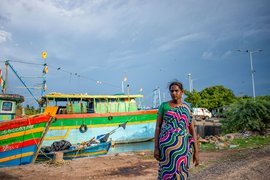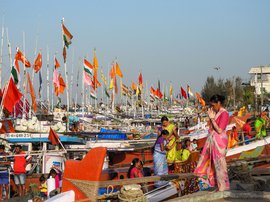ତାଙ୍କ ଭିତରେ ଥିବା ସାହସକୁ ଦେଖି ଜେଜେ ବାପା ତାଙ୍କୁ ‘ପୁଲି’ ନାଁ ଦେଇଥିଲେ, ତାମିଲ ଭାଷାରେ ଏହାର ଅର୍ଥ ହେଉଛି ବାଘ । କେ.ବାନୁମତୀଙ୍କୁ ବନ୍ଦରରେ ସମସ୍ତେ ଏହି ନାଁରେ ହିଁ ଜାଣନ୍ତି । ଏଠାରେ ସେ ସମୁଦ୍ର ପାଖରେ ଦୀର୍ଘ ୪୦ ବର୍ଷରୁ ଅଧିକ ଦିନ ଧରି କାମ କରି ଆସୁଛନ୍ତି। ସେ ବର୍ଜ୍ୟରୁ ଉପଯୋଗୀ ଜିନିଷ ଏବଂ ମାଛ ଅବଶେଷ ସଂଗ୍ରହ କରିବା ସହିତ ସେଗୁଡ଼ିକୁ ପୃଥକ କରି ବିକ୍ରି କରିଥାନ୍ତି। କିନ୍ତୁ ପୁଲି ଏବଂ କଡ଼ଲୁର୍ ମାଛ ଧରା ବନ୍ଦରରେ କାମ କରୁଥିବା ଅନ୍ୟ ମହିଳାମାନଙ୍କୁ ସରକାରୀ ନୀତିରେ ଶ୍ରମିକ ଭାବେ ଗଣାଯାଏ ନାହିଁ, ଫଳରେ ସେମାନେ ବିଭିନ୍ନ ପ୍ରକାର ସୁରକ୍ଷା ଯୋଜନାରୁ ବଞ୍ଚିତ ରହିଛନ୍ତି।
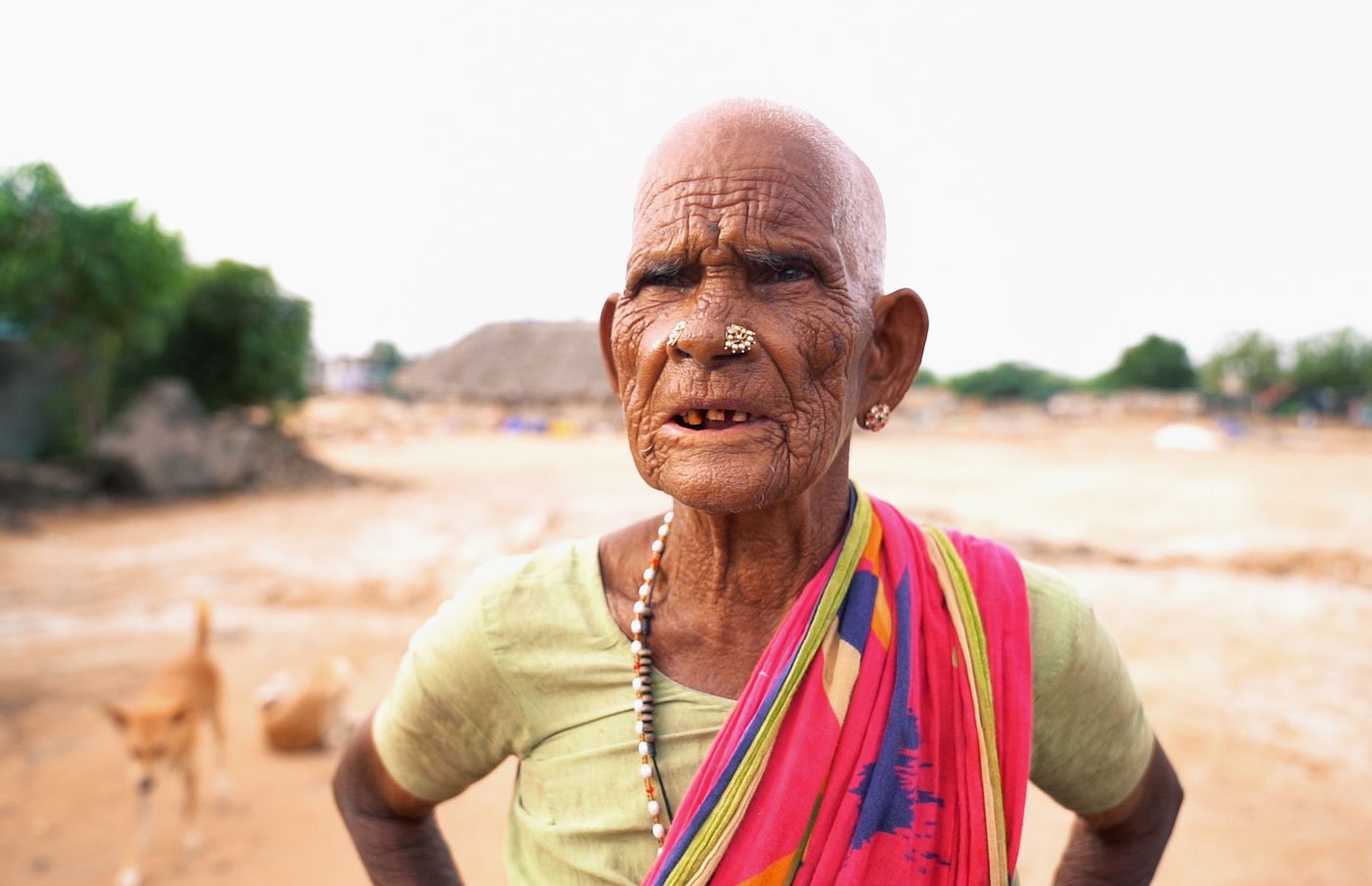
‘‘୭୫ ବର୍ଷ ବୟସରେ ପହଞ୍ଚିଥିବା ପୁଲି କୁହନ୍ତି, ମୋତ୍ରେ ପ୍ରାୟ ୩୫ ବର୍ଷ ହୋଇଥିବା ବେଳେ ମୁଁ ଏଠାକୁ ଆସି ମାଛ ନିଲାମ ଡାକିବା ଆରମ୍ଭ କରିଥିଲି’’। ସହର ପୂର୍ବରେ ଥିବା କଡ଼ଲୁର୍ ଓଲ୍ଡ ଟାଉନ ବନ୍ଦରରେ, ଡଙ୍ଗାଟିଏ କୂଳରେ ପହଞ୍ଚିବା ପରେ ନିଲାମକାରୀମାନେ ବ୍ୟବସାୟୀଙ୍କଠାରୁ ଦର ମୂଲଚାଲ କରିଥାନ୍ତି । ଯଦି ସେମାନେ ଡଙ୍ଗାରେ ନିବେଶ କରିଥାନ୍ତି ତା’ହେଲେ ସେମାନଙ୍କୁ ବିକ୍ରିର ୧୦ ପ୍ରତିଶତ କମିଶନ ଆକାରରେ ମିଳିଥାଏ (ପ୍ରାୟ ୨୦ ବର୍ଷ ପୂର୍ବରୁ, ଏହା ପାଞ୍ଚ ପ୍ରତିଶତ ଥିଲା)। ଅନେକ ବର୍ଷ ପୂର୍ବରୁ ପୁଲି ଯେତେବେଳେ ବନ୍ଦରରେ ପହଞ୍ଚିଲେ, ତାଙ୍କର ସମ୍ପର୍କୀୟମାନେ ତାଙ୍କୁ କାମରେ ନିୟୋଜିତ କରିଥିଲେ, ଏବଂ ଦୁଇଟି ଡଙ୍ଗାରେ ନିବେଶ କରିବା ଲାଗି ପ୍ରାୟ ୫୦,୦୦୦ ଟଙ୍କା ଋଣ ଦେଇଥିଲେ, ଯାହାକୁ ସେ ଶ୍ରମିକ ଭାବେ ଦୀର୍ଘ ଦିନ ଧରି ଘଣ୍ଟା ଘଣ୍ଟା ପରିଶ୍ରମ କରିବା ପରେ ସୁଝି ପାରିଥିଲେ। ବୟସ ବଢ଼ିବା ସହିତ, ପୁଲି ନିଲାମୀ ବନ୍ଦ କରିଦେଲେ ଏବଂ ଏହି କାମ ନିଜ ଝିଅକୁ ଦେଇଦେଲେ।
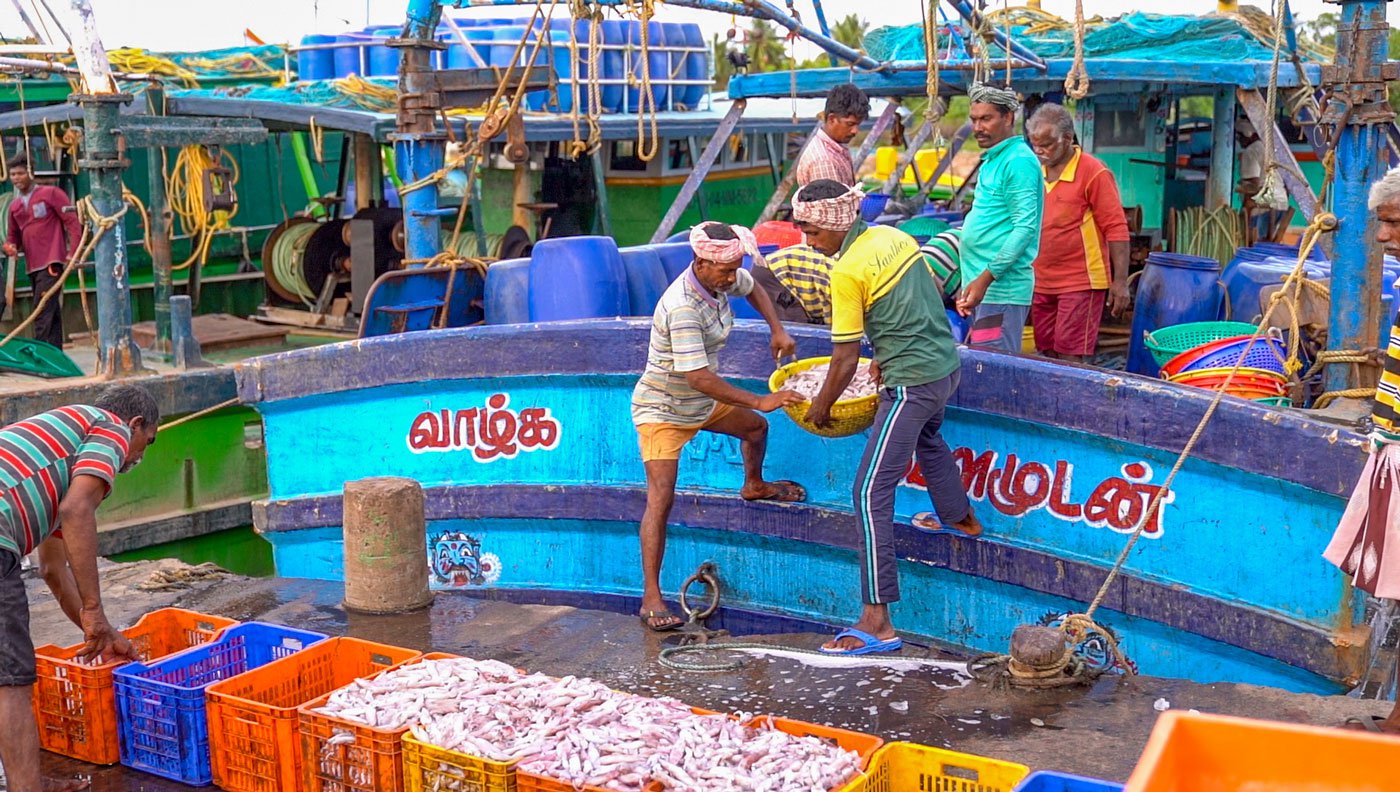
ଏହି ବ୍ୟସ୍ତବହୁଳ ବନ୍ଦର ସବୁବେଳେ କୋଳାହଳପୂର୍ଣ୍ଣ ଥାଏ – ନିଲାମକାରୀମାନେ ନିଲାମ ଆହ୍ୱାନ କରିଥାନ୍ତି, ବ୍ୟବସାୟୀମାନେ ମୂଲଚାଲ କରନ୍ତି, ଲୋଡରମାନେ ମାଛ ବୋହିଥାନ୍ତି, ମେସିନଗୁଡ଼ିକ ବରଫ ଚୁନା କରୁଥାନ୍ତି, ଲରିଗୁଡ଼ିକର ଯାତାୟାତ ଲାଗି ରହିଥାଏ, ବିକ୍ରେତାମାନେ ବ୍ୟବସାୟ କରୁଥାନ୍ତି। ଏହା କଡ଼ଲୁର୍ ଜିଲ୍ଲାର ପ୍ରମୁଖ ମାଛଧରା ବନ୍ଦର ଏବଂ ପୁଲିଙ୍କ ଗ୍ରାମ ସୋତିକୁପ୍ପମ ସମେତ ଅନ୍ୟ ଚାରିଟି ପଡ଼ୋଶୀ ଗ୍ରାମର ମତ୍ସ୍ୟଜୀବୀମାନେ ଏହା ଉପରେ ନିର୍ଭର କରିଥାନ୍ତି। କେନ୍ଦ୍ରୀୟ ସାମୁଦ୍ରିକ ମତ୍ସ୍ୟ ଗବେଷଣା ସଂସ୍ଥାନର ତଥ୍ୟ ଅନୁଯାୟୀ, ପ୍ରାୟ ଏକ ଦଶନ୍ଧି ପୂର୍ବରୁ, ଏହି ୫ଟି ଗ୍ରାମର ମତ୍ସ୍ୟଜୀବୀମାନେ ମିଶି ୨୫୬ଟି ଯାନ୍ତ୍ରିକ ଏବଂ ୮୨୨ଟି ମୋଟର ଚାଳିତ ଡଙ୍ଗା ଚାଲୁଥିଲା (ଅଧିକ ସଦ୍ୟତମ ଡାଟା ଉପଲବ୍ଧ ନାହିଁ)।
![“I’d started my kazhar business at the same time [as when I began working at the harbour],” Puli says, referring to her work of collecting and selling fish waste (the scales, heads, tails of fish, shrimp shells and other parts) and bycatch (such as seashells, shrimp, squid and small fishes). This is called kazhivu meen in Tamil, and, more informally, as kazhar. Puli is one of around 10 women at this harbour who collect fish waste and sell it to poultry feed manufacturers – it's a big industry in neighbouring districts like Namakkal. From Rs. 7 for one kilo of kazhar when she started out, the rate now, Puli says, is Rs. 30 per kilo for fish, Rs. 23 for fish heads and Rs. 12 for crab kazhar.](/media/images/04-Puli-3-NR-Puli_gets_by_on_shells_scales.max-1400x1120.jpg)
ମାଛ ଅବଶେଷ (ମାଛର କାତି, ମୁଣ୍ଡ, ଲାଞ୍ଜ, ଚିଙ୍ଗୁଡ଼ି ଖୋଳପା ଏବଂ ଅନ୍ୟାନ୍ୟ ଅଂଶ) ଏବଂ ବାଏକ୍ୟାଚ୍ (ଶାମୁକା, ଛୋଟ ଚିଙ୍ଗୁଡ଼ି, ସ୍କୁଇଡ ଏବଂ ଛୋଟ ମାଛ ଆଦି) ସଂଗ୍ରହ ଓ ବିକ୍ରି କାମ ବିଷୟରେ ଉଲ୍ଲେଖ କରି ପୁଲି କୁହନ୍ତି, ‘‘ବନ୍ଦରରେ ମୁଁ କାମ ଆରମ୍ଭ କରିବା ପରଠାରୁ ମୁଁ ଏହି ‘କଳର’ ବ୍ୟବସାୟ ଆରମ୍ଭ କରିଥିଲି । ତାମିଲରେ ଏହାକୁ କଳିବୁମିନ୍ କୁହନ୍ତି, କଥିତ ଭାଷାରେ କଳର କୁହାଯାଏ। ପୁଲିଙ୍କ ଭଳି ପ୍ରାୟ ୧୦ ଜଣ ମହିଳା ଏହି ବନ୍ଦରଠାରେ ମାଛ ଅବଶେଷ ସଂଗ୍ରହ କରିଥାନ୍ତି ଏବଂ ଏହାକୁ କୁକୁଡ଼ା ଦାନା ଉତ୍ପାଦନକାରୀମାନଙ୍କୁ ବିକ୍ରି କରିଥାନ୍ତି – ପଡ଼ୋଶୀ ନମକ୍କଲରେ ଏହା ଏକ ବଡ଼ ଉଦ୍ୟୋଗ। ପୁଲି କୁହନ୍ତି, ସେ କାମ ଆରମ୍ଭ କରିବା ସମୟରେ କଳର କିଲୋ ପ୍ରତି ୭ ଟଙ୍କାରେ ବିକ୍ରି ହେଉଥିଲା। ଏବେ ମାଛ କିଲୋ ପ୍ରତି ୩୦ ଟଙ୍କା, ମାଛ ମୁଣ୍ଡ କିଲୋ ପ୍ରତି ୨୩ ଟଙ୍କା ଏବଂ କଙ୍କଡ଼ା କଳର କିଲୋ ପ୍ରତି ୧୨ ଟଙ୍କାରେ ବିକ୍ରି ହେଉଛି ।
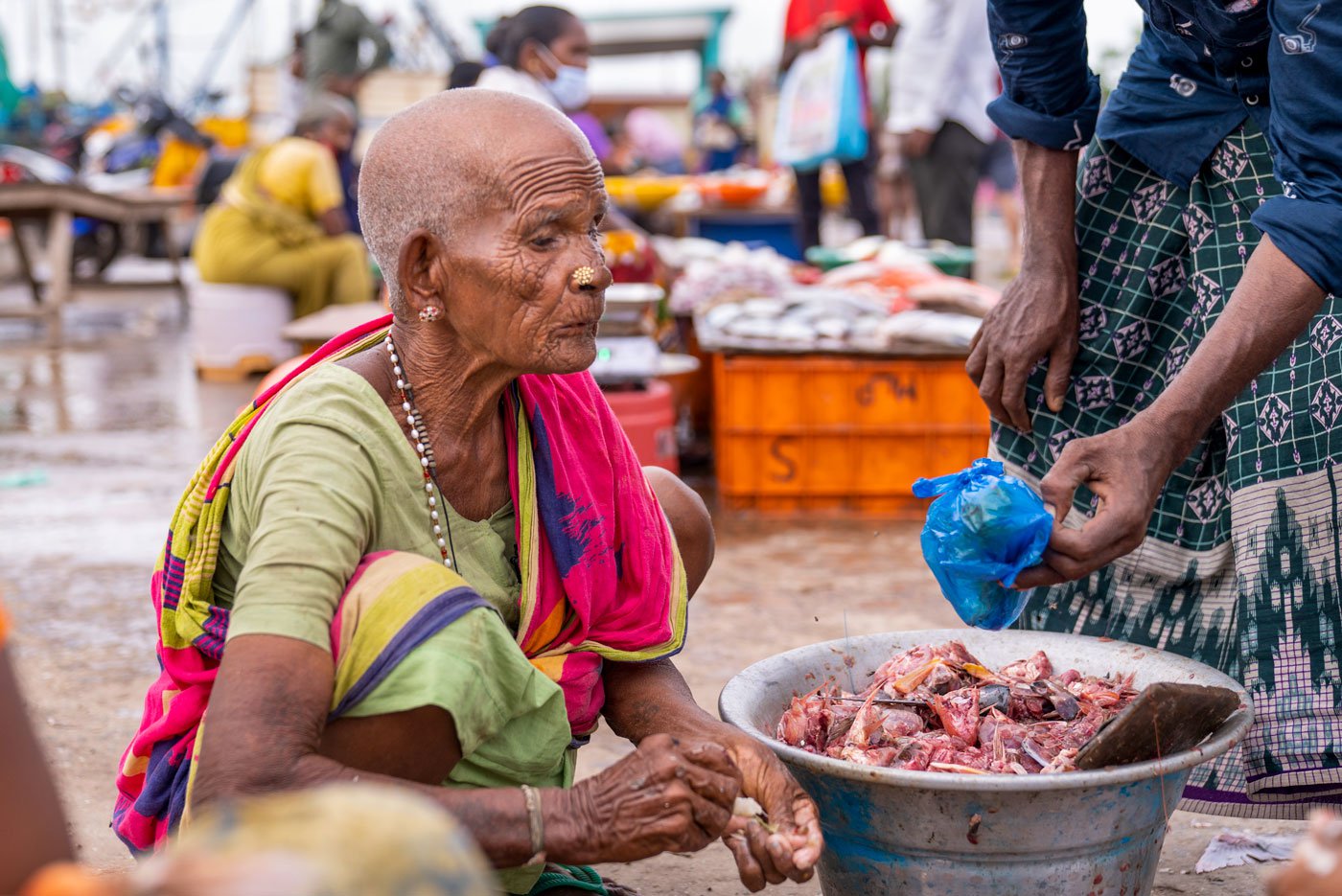
ମାତ୍ର ୧୬ ବର୍ଷ ବୟସରେ ପୁଲି, ନାଗାପଟ୍ଟିନମ ଜିଲ୍ଲାର ଜଣେ ମତ୍ସ୍ୟଜୀବୀଙ୍କୁ ବାହା ହୋଇଥିଲେ। ସେମାନଙ୍କର ଚାରି ଜଣ ପିଲା ଥିଲେ, କିନ୍ତୁ ତାଙ୍କ ସ୍ୱାମୀ କୁପ୍ପୁସ୍ୱାମୀ ଅତ୍ୟନ୍ତ ନିଷ୍ଠୁର ଥିଲେ। ପୁଲିଙ୍କ ବାପା ସୋତିକୁପ୍ପମରେ ପଞ୍ଚାୟତ ମୁଖିଆ ଥିଲେ, ତେଣୁ ସେ ପିଲାମାନଙ୍କ ସହ ବାପ ଘରକୁ ଚାଲି ଆସିବା ଲାଗି ତାଙ୍କୁ ପରାମର୍ଶ ଦେଇଥିଲେ। ତିନି ବର୍ଷ ପରେ ସେ ତାଙ୍କ ମା’ଙ୍କୁ ହରାଇଥିଲେ, ସେ ମଧ୍ୟ ଜଣେ ନିଲାମକାରୀ ଥିଲେ। ପୁଲି କୁହନ୍ତି, ‘‘ଏହାପରେ ମୋ ସମ୍ପର୍କୀୟମାନେ ମୋତେ ନିଲାମ ଡାକିବା କାମ କରିବା ଲାଗି କହିଲେ। ମୋ ପିଲାମାନଙ୍କ ପାଇଁ ମୁଁ ଟଙ୍କା ରୋଜଗାର କରିବାକୁ ଚାହୁଁଥିଲି।’’
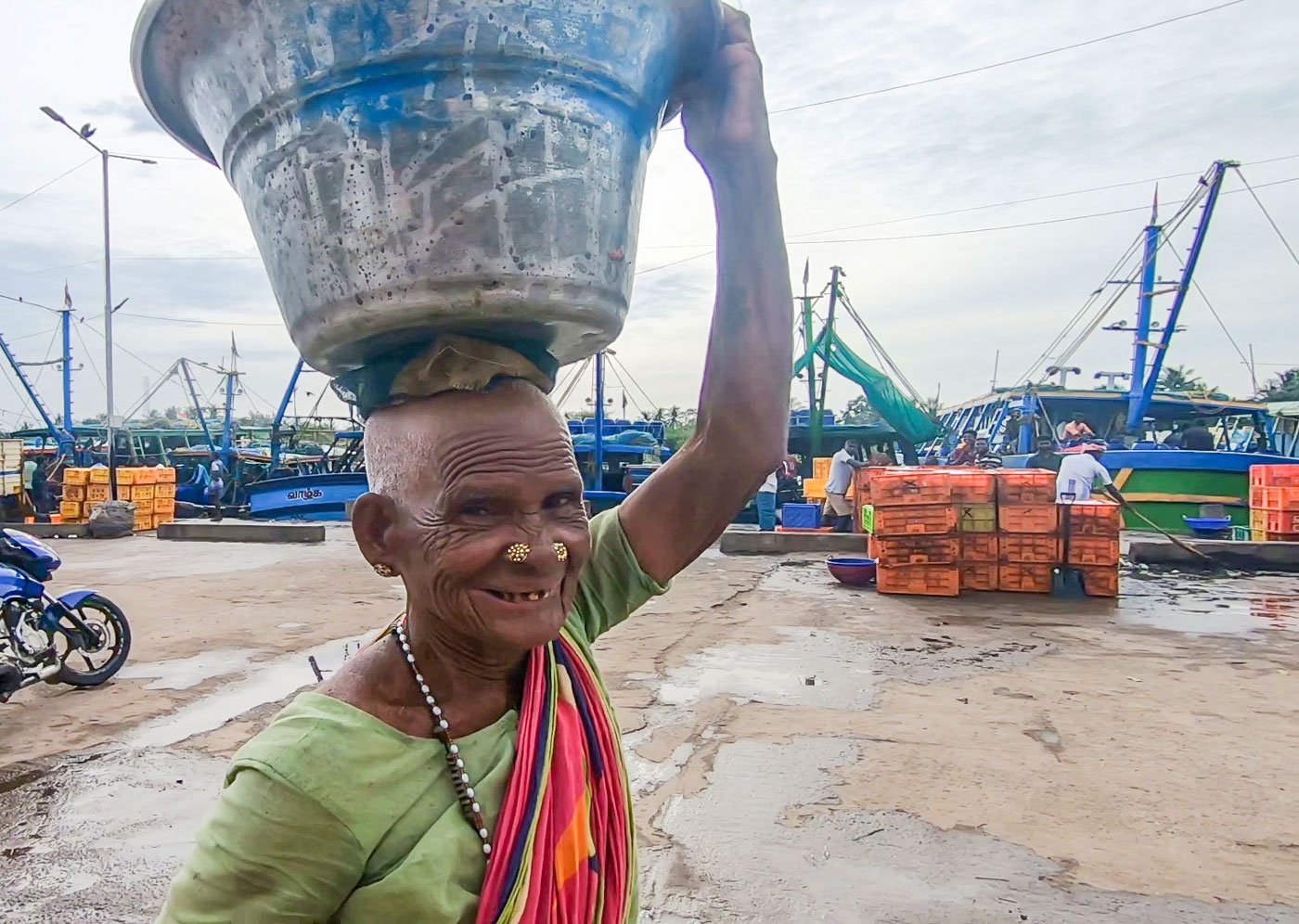
ଭୋର ୪ଟାରୁ ସନ୍ଧ୍ୟା ୬ଟା ପର୍ଯ୍ୟନ୍ତ ସେ ବନ୍ଦରରେ ଥାଆନ୍ତି – ଲୁଣ ଦେବା, ପ୍ୟାକ କରିବା ଏବଂ ବିକ୍ରି କରିବା କାମ କରୁଥାନ୍ତି। ପ୍ରଥମ ଦିନ ଗନ୍ଧ ଦୂର କରିବା ଲାଗି କଳର ରେ ଲୁଣ ଦିଆଯାଇଥାଏ। ଦ୍ୱିତୀୟ ଦିନ ଏହାକୁ ଶୁଖାଇ ଜାଲ ବସ୍ତାରେ ପ୍ୟାକିଂ କରାଯାଇଥାଏ। ଯାହାକୁ ସେ ବନ୍ଦରରୁ ଗୋଟା ୪ ଟଙ୍କା ଦେଇ କିଣିଥାନ୍ତି । ବେଳେ ବେଳେ ସେ ଝୋଟ ଲୁଣ ଅଖାକୁ ପୁନଃବ୍ୟବହାର କରିଥାନ୍ତି ଯାହାକି ଗୋଟାକୁ ୧୫ ଟଙ୍କା ପଡ଼ିଥାଏ।
ଗୋଟିଏ ବସ୍ତା କଳର ରେ ୨୫ କିଗ୍ରା ସାମଗ୍ରୀ ଥାଏ, ପୁଲି କୁହନ୍ତି । ପୂର୍ବରୁ ସେ ଗୋଟିଏ ସପ୍ତାହରେ ୪-୫ ବସ୍ତା ବିକ୍ରି କରିପାରୁଥିଲେ, କିନ୍ତୁ କୋଭିଡ -୧୯ ମହାମାରୀ ସହିତ, ରିଙ୍ଗ ସିନ ଜାଲ ଉପରେ ପ୍ରତିବନ୍ଧକ ଲାଗୁ ହେବା ଫଳରେ ମାଛ ଧରା କମିଯାଇଛି ଏବଂ ବ୍ୟବସାୟ ମଧ୍ୟ ହ୍ରାସ ପାଇଛି। ଏବେ ସେ ନମକ୍କଲର କ୍ରେତାମାନଙ୍କୁ ଗୋଟିଏ ସପ୍ତାହରେ ଦୁଇ ବସ୍ତା ବିକ୍ରି କରିପାରୁଛନ୍ତି। ଏଥିରୁ ସେ ସପ୍ତାହକୁ ପ୍ରାୟ ୧୨୫୦ ଟଙ୍କା ରୋଜଗାର କରିଥାନ୍ତି ।
କଡ଼ଲୁର୍ ବନ୍ଦରରେ ମହିଳାମାନେ ସବୁ କାମରେ ନିୟୋଜିତ ଥାଆନ୍ତି – ଯେପରିକି ନିଲାମ ଡାକିବା, ବିକ୍ରି କରିବା, ମାଛ ଶୁଖାଇବା କିମ୍ବା କଳର ଅଲଗା କରିବା ଆଦି । ହେଲେ ସେମାନଙ୍କର ଦୈନିକ ଆୟ ଅସ୍ଥିର ବୋଲି ସେମାନେ କହିଥାନ୍ତି। ମତ୍ସ୍ୟଜୀବୀମାନଙ୍କ ଗାଁର ଅଧିକାଂଶ ମହିଳା ଏବେ ମାଛ ଧରା କାମରେ ନିୟୋଜିତ ହେବାକୁ ରାଜି ହେଉନାହାନ୍ତି । ଫଳରେ, ମୁଖ୍ୟତଃ ବୟସ୍କ ମହିଳାମାନେ ହିଁ ବନ୍ଦରରେ କାମ କରୁଛନ୍ତି ।
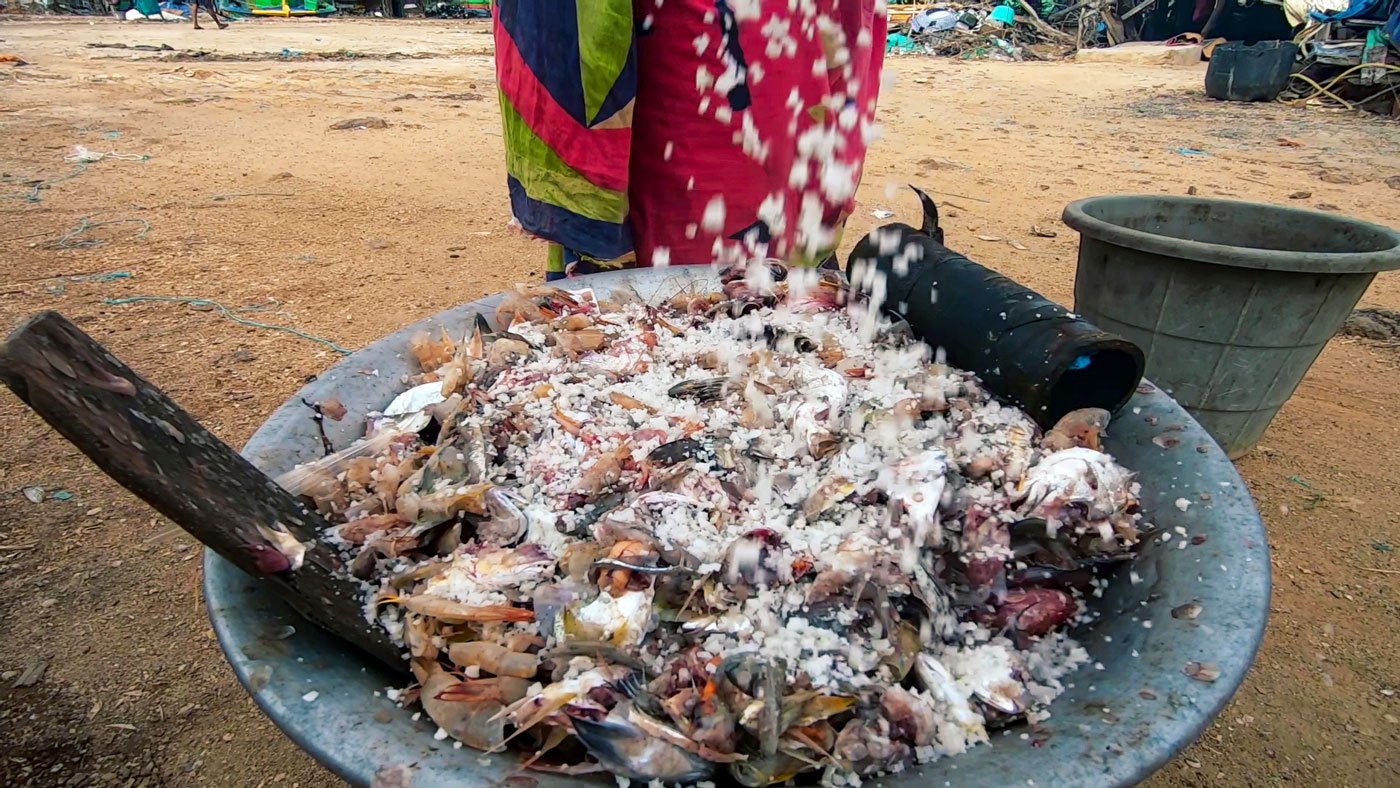
ପୁଲି କୁହନ୍ତି, ‘‘କଳର ଆଣିବା ପାଇଁ ମୋତେ କିଛି ଟଙ୍କା ଦେବାକୁ ପଡ଼େ ନାହିଁ । ବନ୍ଦରରେ ମାଛ କାଟୁଥିବା ମହିଳାମାନଙ୍କ ଠାରୁ ମୁଁ ଏସବୁ ସଂଗ୍ରହ କରିଥାଏ।’’ ପ୍ରତିଦିନ ଭୋର ୪ଟାରୁ ଉଠି ସେ ମାଛ ଅବଶେଷ ସଂଗ୍ରହ କରିବା ଆରମ୍ଭ କରିଥାନ୍ତି । ଗ୍ରାହକଙ୍କ ଆବଶ୍ୟକତା ଅନୁଯାୟୀ ମାଛ ଅବଶେଷ ଅଲଗା ଫିଙ୍ଗି ଦେଉଥିବା ବିକ୍ରେତା ଏବଂ ଅନ୍ୟମାନଙ୍କଠାରୁ ସେ ଏସବୁ ଆଣିଥାନ୍ତି । ଯଦିଓ କଳର ପାଇଁ ପୁଲିଙ୍କୁ କିଛି ଟଙ୍କା ଖର୍ଚ୍ଚ କରିବାକୁ ପଡ଼େ ନାହିଁ, ସେ ବେଳେ ବେଳେ ବିକ୍ରେତା ଓ ମାଛ କଟାଳିଙ୍କ ପାଇଁ କୋଲ୍ଡ ଡ୍ରିଙ୍କସ୍ କିଣି ଦେଇଥାନ୍ତି । ସେ କୁହନ୍ତି, ‘‘ମୁଁ ସେମାନଙ୍କ କାମ କରିବା ସ୍ଥାନକୁ ସଫା କରିବାରେ ସାହାଯ୍ୟ କରେ। ସେମାନଙ୍କ ସହ କଥା ହୁଏ ଏବଂ ଆମେ ପରସ୍ପର ମଧ୍ୟରେ ଖବର ଆଦାନପ୍ରଦାନ କରିଥାଉ।’’
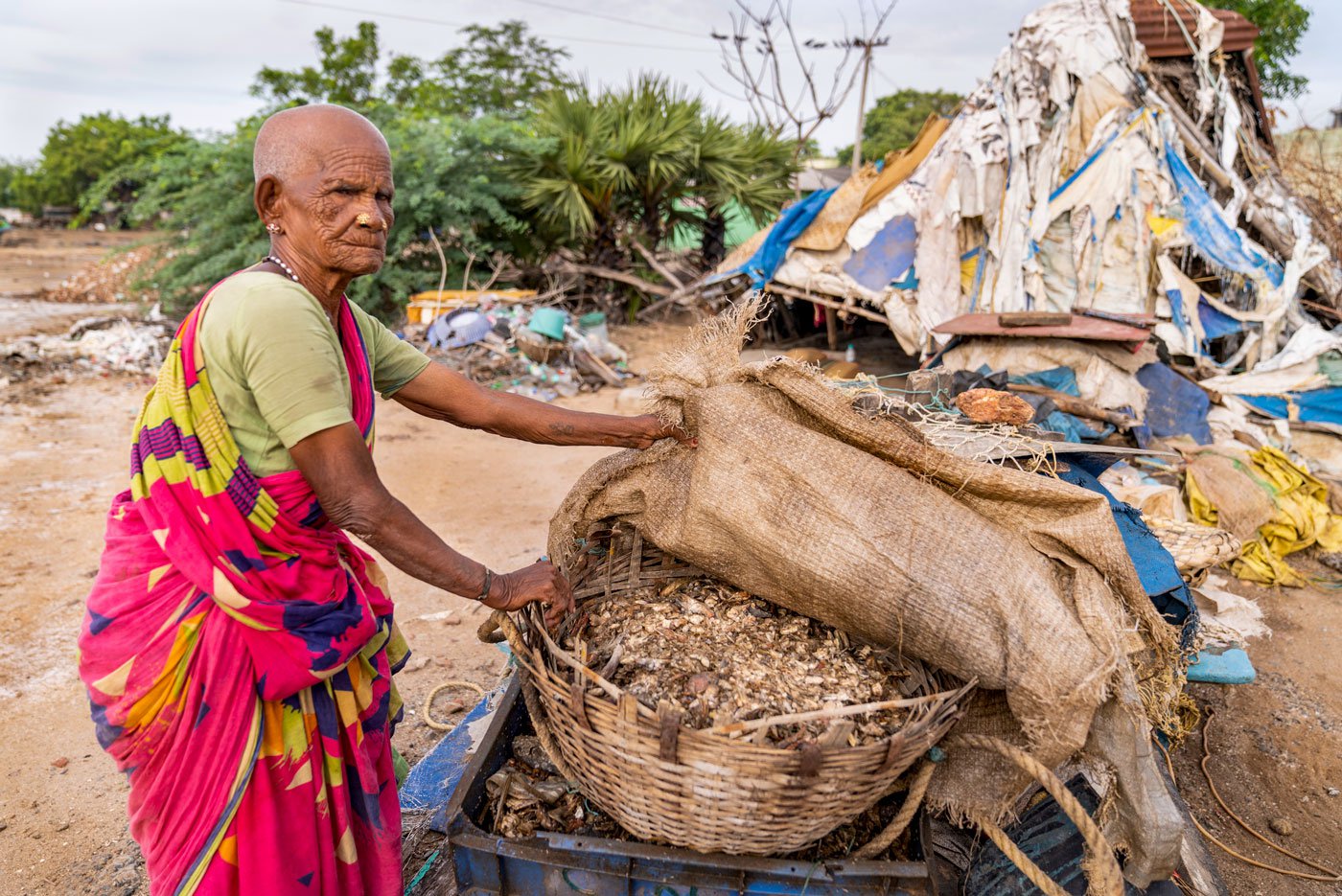
କଡ଼ଲୁର୍ ବନ୍ଦରରେ ମହିଳାମାନେ ବିଭିନ୍ନ ପ୍ରକାରର କାର୍ଯ୍ୟ କରିଥାନ୍ତି, ଯାହାକି ସିଧାସଳଖ ପ୍ରତ୍ୟକ୍ଷ ଏବଂ ପରୋକ୍ଷ ଭାବେ ମାଛ ବିକ୍ରି ଓ ପ୍ରକ୍ରିୟାକରଣ ସହ ଜଡ଼ିତ। ମହିଳାମାନେ ଏଠାରେ ମତ୍ସ୍ୟଜୀବୀମାନଙ୍କ ପାଇଁ ବରଫ, ଚା’ ଏବଂ ରନ୍ଧା ଖାଦ୍ୟ ବିକ୍ରି କରିଥାନ୍ତି। ସବୁ ମାଛ ଧରା ପରବର୍ତ୍ତୀ କାର୍ଯ୍ୟକଳାପରେ ୬୯ ପ୍ରତିଶତ ମହିଳା ନିୟୋଜିତ ଥିବା ଜାତୀୟ ମତ୍ସ୍ୟ ନୀତି ୨୦୨୦ରେ ଉଲ୍ଲେଖ ରହିଛି। ଯଦି ଏହାକୁ ଗଣାଯାଏ ତା’ହେଲେ ମତ୍ସ୍ୟ ଉତ୍ପାଦନକୁ ମହିଳାଙ୍କ ପ୍ରାଧାନ୍ୟ ଥିବା ଏକ କ୍ଷେତ୍ର ଭାବେ ବିବେଚନା କରାଯାଇପାରିବ ।
କାର୍ଯ୍ୟ ପରିସ୍ଥିତିରେ ସୁଧାର ଆଣିବା ଲାଗି ସମବାୟ ସଂସ୍ଥା, ବିଭିନ୍ନ ଯୋଜନା ଏବଂ ଅନ୍ୟାନ୍ୟ ପଦକ୍ଷେପ ଜରିଆରେ ମତ୍ସ୍ୟପାଳନ କ୍ଷେତ୍ରରେ ମହିଳାମାନଙ୍କର ସମ୍ପୃକ୍ତି ବଢ଼ାଇବାର ଆବଶ୍ୟକତା ରହିଥିବା ୨୦୨୦ର ଏହି ନୀତିରେ ଉଲ୍ଲେଖ କରାଯାଇଛି । ତେବେ, ମତ୍ସ୍ୟ ଉତ୍ପାଦନ ପରବର୍ତ୍ତୀ କାର୍ଯ୍ୟରେ ନିୟୋଜିତ ରହିଥିବା ମହିଳାଙ୍କ ସମସ୍ୟା ସମାଧାନ କରିବା ପରିବର୍ତ୍ତେ ଏସବୁ ଯୋଜନାର ଧ୍ୟାନ କେବଳ ଯାନ୍ତ୍ରିକୀକରଣ ଉପରେ ରହିଛି ।
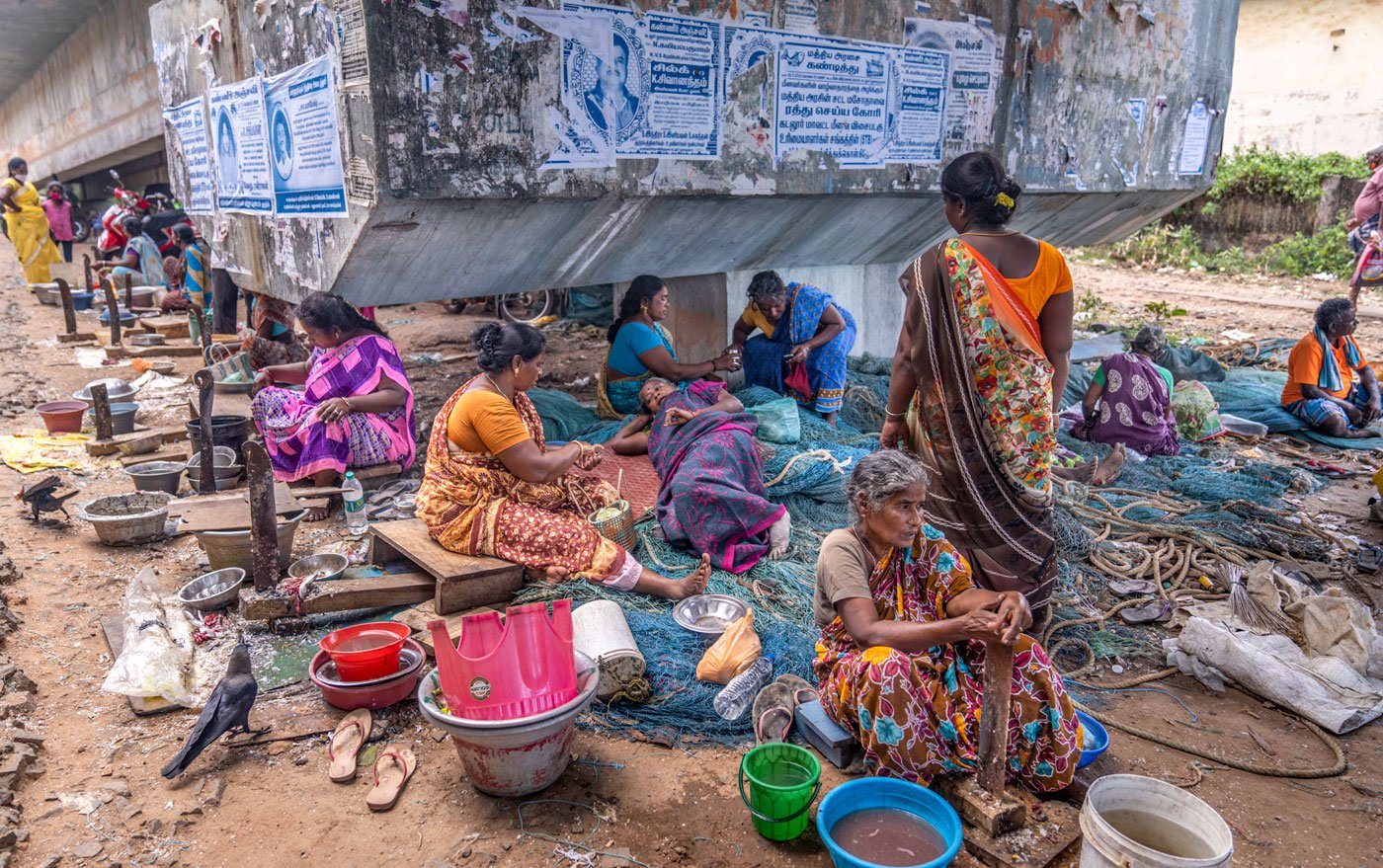
ଉପକୂଳୀୟ ପରିବର୍ତ୍ତନ ଏବଂ ପୁଞ୍ଜି ଆଧାରିତ ମତ୍ସ୍ୟ ଉତ୍ପାଦନ ଓ ରପ୍ତାନି ଲାଗି ନୀତିଗତ ପ୍ରୋତ୍ସାହନ ଯୋଗୁଁ ଏସବୁ ପଦକ୍ଷେପ ମତ୍ସ୍ୟପାଳନ କ୍ଷେତ୍ରରେ ମହିଳାମାନଙ୍କୁ ସହାୟତା କରିବା ପରିବର୍ତ୍ତେ, ସେମାନେ ଅଧିକରୁ ଅଧିକ ଅବହେଳିତ ହୋଇପଡ଼ୁଛନ୍ତି । ଏସବୁ ପରିବର୍ତ୍ତନ ଏ କ୍ଷେତ୍ରରେ ମହିଳାମାନଙ୍କ ଯୋଗଦାନକୁ ସେତେଟା ଗ୍ରହଣ କରୁନାହିଁ । ମହିଳାମାନେ ଅବହେଳିତ ହେବାର ଅନ୍ୟସବୁ କାରଣ ମଧ୍ୟରେ ରହିଛି – ବ୍ୟାପକ ମିଶ୍ରିତ ଭିତ୍ତିଭୂମି (ମାକ୍ରୋ ଇନଫ୍ରାଷ୍ଟ୍ରକଚର) କ୍ଷେତ୍ରରେ ନିବେଶ ବୃଦ୍ଧି, ୧୯୭୨ରେ ସାମୁଦ୍ରିକ ଉତ୍ପାଦ ରପ୍ତାନି ବିକାଶ ପ୍ରାଧିକରଣ ପ୍ରତିଷ୍ଠା ଆଦି । ଏହା ରପ୍ତାନି ବୃଦ୍ଧି କରିଥିବା ବେଳେ କ୍ଷୁଦ୍ର ମତ୍ସ୍ୟ ଉତ୍ପାଦନକାରୀମାନଙ୍କୁ କ୍ଷତି ପହଞ୍ଚାଇଛି । ୨୦୦୪ ସୁନାମି ପରେ ଏହି ପ୍ରକ୍ରିୟା ଅଧିକ ଗତିଶୀଳ ହୋଇଛି, କାରଣ ସେବେଠାରୁ ନୂଆ ଡଙ୍ଗା ଏବଂ ଉପକରଣରେ ଅଧିକ ଟଙ୍କା ନିବେଶ କରାଯାଇଛି ।
ଦିନକୁ ଦିନ, ଅଧିକରୁ ଅଧିକ ସଂଖ୍ୟାରେ ମହିଳା ମତ୍ସ୍ୟ ଉତ୍ପାଦନ ପରବର୍ତ୍ତୀ କାର୍ଯ୍ୟକଳାପଠାରୁ ଦୂରେଇ ଯାଉଛନ୍ତି। ମାଛ ବିକ୍ରି, କାଟିବା, ଶୁଖାଇବା ଏବଂ ଅବଶେଷ ବାହାର କରିବା ଭଳି ସେମାନଙ୍କ କାମ ପାଇଁ ଏଠାରେ ସ୍ଥାନାଭାବ ଦେଖାଦେଇଥିବା କଡ଼ଲୁର୍ ବନ୍ଦରରେ ଥିବା ମହିଳାମାନେ କହିଛନ୍ତି। କେବଳ ଅଳ୍ପ କିଛି ମହିଳା ବ୍ୟବସାୟୀଙ୍କୁ ସରକାରୀ ସଂସ୍ଥା ପକ୍ଷରୁ ବରଫ ବାକ୍ସ ମିଳିଛି। ସେହିପରି ହାତଗଣତି ଗାଁ ଓ ସହରରେ ଥିବା ବଜାରରେ ସେମାନଙ୍କୁ ମାଛ ବିକ୍ରି ପାଇଁ ସ୍ଥାନ ଆବଣ୍ଟନ କରାଯାଇଛି। ଅଧିକାଂଶ ସମୟରେ, ଯାତାୟାତ ପାଇଁ ସୁବିଧା ନଥିବାରୁ ମାଛ ବିକ୍ରି ପାଇଁ ସେମାନଙ୍କୁ ଅନେକ ଦୂର ପର୍ଯ୍ୟନ୍ତ ପାଦରେ ଚାଲି ଚାଲି ଯିବାକୁ ପଡ଼ୁଛି ।
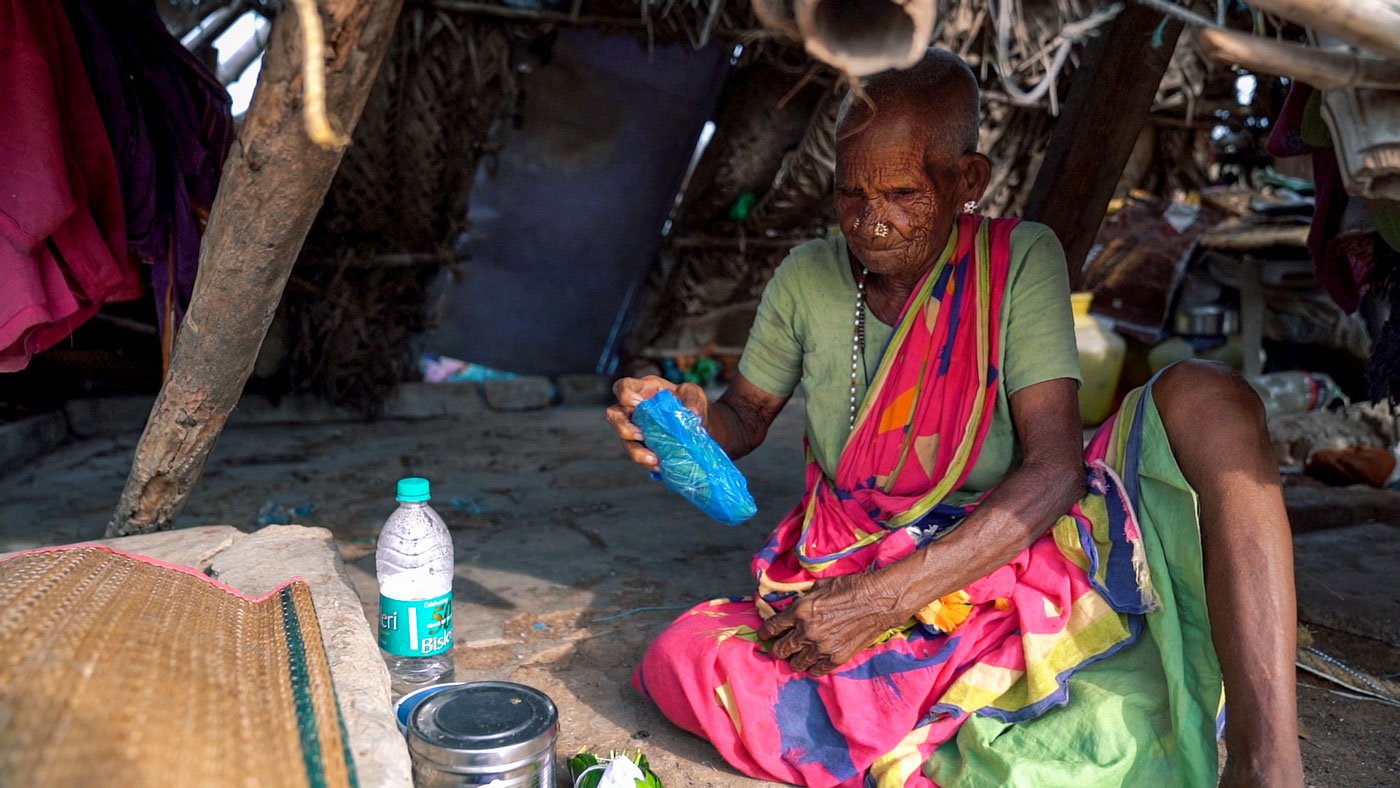
ପୁଲି କୁହନ୍ତି, ‘‘ମୁଁ ଏଠାରେ ବନ୍ଦର ପରିସରରେ ଏକ ଛୋଟ କୁଡ଼ିଆରେ ରହିଥାଏ, ଯାହାଫଳରେ ମୁଁ ସହଜରେ ନିଜ ବେପାର ଜାଗାରେ ପହଞ୍ଚିପାରିବି।’’ କିନ୍ତୁ ବର୍ଷା ହେଲେ ସେ ତାଙ୍କ ପୁଅ ମୁଥୁଙ୍କ ଘରକୁ ଚାଲି ଯାଇଥାନ୍ତି, ଯାହାକି ଏଠାରୁ ପ୍ରାୟ ତିନି କିଲୋମିଟର ଦୂର ସୋତିକୁପ୍ପମରେ ରହିଛି। ୫୮ ବର୍ଷୀୟ ମୁଥୁ ବନ୍ଦରରେ ଜଣେ ମତ୍ସ୍ୟଜୀବୀ ଭାବେ କାମ କରିଥାନ୍ତି । ସେ ସବୁଦିନ କାମକୁ ମା’ଙ୍କ ପାଇଁ ଖାଦ୍ୟ ନେଇ ଆସିଥାନ୍ତି। ବାର୍ଦ୍ଧକ୍ୟ ଭତ୍ତା ଆକାରରେ ପୁଲିଙ୍କୁ ମାସିକ ୧୦୦୦ ଟଙ୍କା ମିଳିଥାଏ। ପୁଲି ମାଛ କାମରୁ ଯେତିକି ଟଙ୍କା ରୋଜଗାର କରିଥାନ୍ତି, ସେଥିରୁ ଅଧିକାଂଶ ସେ ନିଜର ପିଲା - ଦୁଇ ପୁଅ ଏବଂ ଦୁଇ ଝିଅ ମାନଙ୍କୁ ଦେଇ ଦିଅନ୍ତି । ତାଙ୍କର ପିଲାମାନେ ୪୦ ଓ ୫୦ ବର୍ଷ ବୟସ ଟପି ସାରିଲେଣି ଏବଂ ସମସ୍ତେ କଡ଼ଲୁର୍ ଜିଲ୍ଲାରେ ମତ୍ସ୍ୟ ଉତ୍ପାଦନ ବେଉସାରେ ନିୟୋଜିତ ଅଛନ୍ତି। ‘‘ସାଥୀରେ ମୁଁ କ’ଣ ନେଇଯିବି?’’ ସେ ପ୍ରଶ୍ନ କରନ୍ତି । ‘‘କିଛି ନୁହେଁ।’’
ୟୁ ଦିବ୍ୟାୟୁତିରନଙ୍କ ସହଯୋଗରେ
ଅନୁବାଦ: ଓଡ଼ିଶାଲାଇଭ୍
